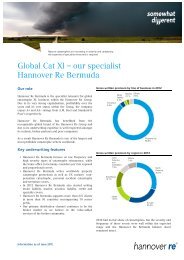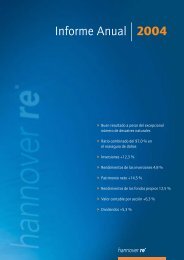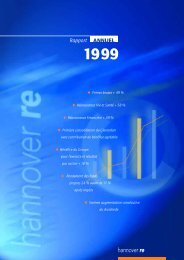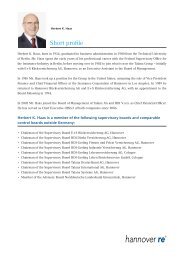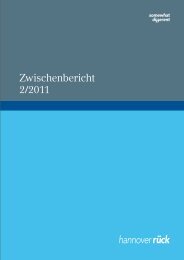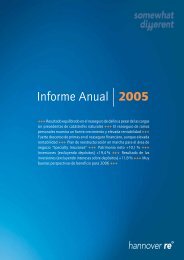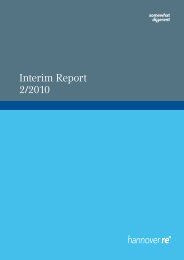Annual Report 2010 - Hannover Re
Annual Report 2010 - Hannover Re
Annual Report 2010 - Hannover Re
You also want an ePaper? Increase the reach of your titles
YUMPU automatically turns print PDFs into web optimized ePapers that Google loves.
Deferred tax liabilities: in accordance with IAS 12 “Income<br />
Taxes” deferred tax liabilities must be recognised if assets<br />
are to be recognised in a higher amount or liabilities in a<br />
lower amount in the consolidated balance sheet than in the tax<br />
balance sheet and if these temporary differences will lead to<br />
additional tax loads in the future; please see our explanatory<br />
remarks on deferred tax assets.<br />
Long-term liabilities principally consist of subordinated debts<br />
that can only be satisfied after the claims of other creditors<br />
in the event of liquidation or bankruptcy. They are measured<br />
at amortised cost. Liabilities to holders of minority shares in<br />
partnerships arising out of long-term capital commitments are<br />
measured at the fair value of the redemption amount as at the<br />
balance sheet date.<br />
Financial liabilities at fair value through profit or loss: <strong>Hannover</strong><br />
<strong>Re</strong> does not make use of the fair value option provided<br />
by IAS 39 “Financial Instruments: <strong>Re</strong>cognition and Measurement”<br />
to classify financial liabilities in this category upon firsttime<br />
recognition.<br />
Shareholders‘ equity: the items “common shares” and “additional<br />
paid-in capital” are comprised of the amounts paid in<br />
by the parent company‘s shareholders on its shares. In addition<br />
to the statutory reserves of the parent company and the<br />
allocations from net income, the retained earnings consist of<br />
reinvested profits generated by the <strong>Hannover</strong> <strong>Re</strong> Group companies<br />
in previous periods. What is more, in the event of a<br />
retrospective change of accounting policies, the adjustment<br />
for previous periods is recognised in the opening balance<br />
sheet value of the retained earnings and comparable items of<br />
the earliest reported period. Unrealised gains and losses from<br />
the fair value measurement of financial instruments held as<br />
available for sale are carried in cumulative other comprehensive<br />
income under unrealised gains and losses on investments.<br />
Translation differences resulting from the currency translation<br />
of separate financial statements of foreign subsidiaries are<br />
recognised under gains and losses from currency translation.<br />
Minority interests are shares in the equity of affiliated companies<br />
not held by companies belonging to the Group. IAS 1<br />
“Presentation of Financial Statements” requires that minority<br />
interests be recognised separately within Group shareholders‘<br />
equity. The minority interest in profit or loss is shown<br />
separately as profit appropriation following the net income<br />
(“thereof” note). This item refers mainly to minority interests<br />
in E+S Rück.<br />
Disclosures about financial instruments: IFRS 7 “Financial<br />
Instruments: Disclosures” requires more extensive disclosures<br />
according to classes of financial instruments. In this context,<br />
the term “class” refers to the classification of financial instruments<br />
according to their risk characteristics. A minimum distinction<br />
is required here between measurement at amortised<br />
cost or at fair value. A more extensive or divergent distinction<br />
should, however, be geared to the purpose of the corresponding<br />
disclosures in the notes. In contrast, the term “category”<br />
is used within the meaning of the measurement categories<br />
defined in IAS 39 “Financial Instruments: <strong>Re</strong>cognition and<br />
Measurement” (held to maturity, loans and receivables, available<br />
for sale and financial assets at fair value through profit or<br />
loss with the subcategories of trading and designated financial<br />
instruments). Essentially, the following classes of financial instruments<br />
are established:<br />
• Fixed-income securities<br />
• Equities, equity funds and other variable-yield securities<br />
• Other financial assets – at fair value through profit or loss<br />
• Other invested assets<br />
• Short-term investments<br />
• Funds withheld and contract deposits (assets)<br />
• Accounts receivable<br />
• Other receivables<br />
• Funds withheld and contract deposits (liabilities)<br />
• Other liabilities<br />
• Long-term debt<br />
• Subordinated debt<br />
• Other long-term liabilities<br />
This grouping into classes is not, however, solely determinative<br />
for the type and structure of each disclosure in the notes.<br />
Rather, guided by the underlying business model of reinsurance,<br />
the disclosures are made on the basis of the facts and<br />
circumstances existing in the financial year and in light of the<br />
principle of materiality.<br />
Currency translation: financial statements of Group subsidiaries<br />
were drawn up in the currencies corresponding to the<br />
economic environment in which each subsidiary primarily<br />
operates. These currencies are referred to as functional currencies.<br />
The euro is the reporting currency in which the consolidated<br />
financial statement is prepared.<br />
Transactions in foreign currencies reported in Group com -<br />
p anies’ individual financial statements are converted into the<br />
functional currency at the transaction rate. In accordance<br />
with IAS 21 “The Effects of Changes in Foreign Exchange<br />
Rates” the recognition of exchange differences on translation<br />
is guided by the nature of the underlying balance sheet item.<br />
Exchange differences from the translation of monetary assets<br />
and liabilities are recognised directly in the statement of in-<br />
120 NOTES 3.2 Summary of major accounting policies<br />
<strong>Hannover</strong> <strong>Re</strong> Group annual report <strong>2010</strong>



